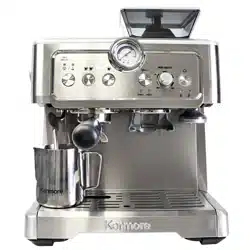Loading ...
Loading ...
Loading ...

PREHEATING & STANDBY
Once the water tank and bean hopper are correctly installed, plug the power cord into the power
outlet. All the indicator lights will flash red and the machine will beep once. Make sure the steam
control knob is in the position and set your heat-safe cups on top of the machine to warm.
Press the power button to start heating the water. The , , and indicators will light
up red and flash slowly and you will hear a water pumping sound. When preheating is complete,
the machine will beep once and the , , and indicators will change to white and stay
lit to show that the machine has entered standby mode.
NOTE - If the steam knob is in the on position during preheating, the indicator
lights will flash red as a warning.
FLUSHING THE SYSTEM
Flushing the system simply means running hot water and steam through the various parts of your
machine without ground coffee. Regularly flushing the system will help keep your machine in the
best possible condition. It is especially important before using the machine for the first time or
after a period of disuse.
1. Fill the water tank to the MAX marking and preheat
the machine.
2. Once the machine reaches standby mode, press the
2-cup/double shot button to run hot water
through the group head into the drip tray, milk
pitcher, or an empty heat-safe cup. Repeat 1-2 more
times.
3. Position the steam wand over the drip tray (Figure
3), milk pitcher, or an empty heat-safe cup and press
and hold the steam/hot water button for 2
seconds. You will hear 2 beeps and the steam in-
dicator will slowly flash red as the machine preheats
to steaming temperature.
4. When preheating is complete, the machine will beep once and the steam indicator will turn
white. Turn the steam control knob all the way to the position to run steam through the
wand for 10 seconds, then return to the position.
5. Press the steam/hot water button to run hot water through the hot water outlet for
about 10 seconds. The hot water indicator will slowly flash white while the hot water is
running. Press the button again to stop the water.
SETTING UP YOUR ESPRESSO MAKER
10 11
SETTING UP YOUR ESPRESSO MAKER
WARNING - The steam wand will get very hot. Always use the safe-
to-touch grip when moving it and avoid touching the bare metal.
WARNING - Make sure the steam wand is pointed all the way to
the right to reduce the chance of steaming hot water splattering
up or running off the side of the drip tray.
6. Check the drip tray or cup after each step
and empty as needed to prevent overflowing.
The red "tray full" indicator will pop up to let
you know when the drip tray needs to be
emptied. (Figure 5)
7. Repeat steps 3-6 until the water tank is empty.
DISPENSING HOT WATER
Once preheated, your machine can dispense hot water from either the hot water tap to the left of
the group head or the tip of the steaming wand. You can use this hot water to rinse or preheat
your cups and milk pitcher or to top up your espresso shot to make a cafe Americano.
To dispense from the hot water tap, press the button. You will hear the pump working
and the indicator light will flash while the water is flowing. Press the button again to
stop.
NOTE - If you do not press the to stop it, the hot water will automatically stop after about
35 seconds and the machine will return to standby mode.
To dispense hot water from the tip of the steam wand, turn the steam control knob all the way
to the position. Hot water will flow continuously from the tip of the steam wand until you
turn the knob back to the position.
WARNING - Check and empty the drip tray regularly to prevent
overflowing. Use extreme caution when emptying as the metal
tray cover and water will be very hot.
WARNING - Use extreme caution when dispensing hot water!
To prevent burns or scalds, avoid contact with the hot water tap
and always use the safe-to-touch grip to move the steam wand.
TRAY FULLTRAY EMPTY
Fig. 3
Loading ...
Loading ...
Loading ...
